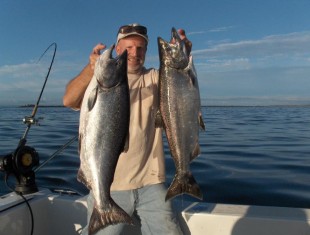EARL SANDE
My first encounter with the famous ‘western thatching ant’ occurred during the early 1960s while visiting relatives near the town of Tenino.
Like most kids of that era we were allowed to spend all day outside roaming and exploring the local area without our parents knowing exactly where we were.
We were enthralled with these mounds of tiny twigs two to three feet high covered with red-headed ants. We knew better then to get too close as there were thousands of ants scurrying about looking like they knew what they were doing.
We decided it would be fun to feed the ants! So we set out on our little mission to find various insects to throw on the ant hill. We soon discovered that this was like feeding raw meat to hundreds of half-inch long grizzly bears. They quickly subdued their unexpected prey and carried them deeper into the ant hill to help feed their many family members.
Like many of our insects, ants have a distant past going back hundreds of millions of years. Most ants are beneficial to the environment but some species can be a pain if they decide to move into your house.
The western thatching ant is usually a good neighbor by staying away from the house. They feed on just about anything dead or alive and sometimes help control the population of carpenter ants and spiders.
Western thatching ants (Formica Obscuripes) are quite common throughout western Canada and the central-western United States. They are acknowledged in the scientific paper work written during the Lewis and Clark Expedition in the early 1800s.
A new colony is started after some winged male and females leave the nest and mate. The male soon dies and the newly fertilized queen gets rid of her wings after she finds a suitable location with just the right amount of sunshine, and digs into the ground to start laying eggs.
As the new members evolve into worker female ants the new colony starts taking shape. They start collecting food and tiny twigs, and the workers also dig deeper into the ground making many tunnels and chambers for more space to increase their population.
Usually if the thatch part of the nest is three-feet tall the underground part of the nest is three feet below ground level. Then before long thousands of ants are working for the good of the colony.
Sometimes more then one ant hill forms a colony. One was studied in Oregon that had 200 nests with a population of over 56 million ants!
Besides collecting food on the ground for the colony coffers, they sometimes farm a group of aphids harvesting honeydew they make from the plant.
They also climb up trees looking for live food and are important predators of the western spruce budworm and other forest pests.
The expertly placed thatch by thousands of workers helps protect the nest from rain, wind, snow, cold and heat.
The ants aren’t very active until the outside temperature is above 50 degrees, but in winter the sun can warm the interior of the nest because of all the organic material above ground. When it gets cold all this organic material helps insulates the below ground part of the nest for better winter survival. With a little luck nests have been known to survive for over 40 years.
Picking up a handful of these red-headed ants would be a poor choice, as your enjoyment of these little buggers would quickly deteriorate. First they would spray you with formic acid from the front end and then bitten. Then something unpleasant might happen from the rear end.
But on the positive side, if you are lost and hungry, just drop a bunch of them in a cup of hot water and drink the liquid after it cools and chew up the remains for an interesting nutritional meal.
We are not sure if Native Americans ate them but there are stories about when they temporarily stored some food they would sometimes spread thatch from an abandon nest around the food and the formic acid smell would keep the mice and pack rats away.
Another interesting thing about thatching ants is why some birds do this weird thing called anting?
Starlings, robins, crows, jays and flickers have been seen standing on an ant nest with a beak full of ants preening their feathers with formic acid or the repugnant anal fluid and no one knows exactly why.
In a report by the Washington Department of Fish and Wildlife, some possibilities are soothing irritated skin associated with feather emergence during molt, general feather maintenance, repelling ectoparasites, inhibiting fungal or bacterial growth, food preparation by removing distasteful substances from prey, and pleasurable sensory stimulation.
The report goes on to say most of these reasons are unlikely, but they must do this for some reason. Since this is not the most pressing question on earth we may never know the answer.
Like many creatures that live and survive near us, thatching ants have an interesting life history. There are two nests on the property where we live and on a sunny day I sometimes find myself watching them work and wondering if they all know what the plan is, or if they just keep busy and something good for the colony will eventually get done.


